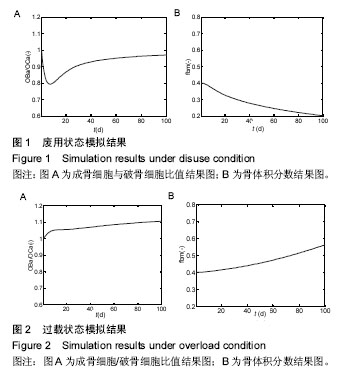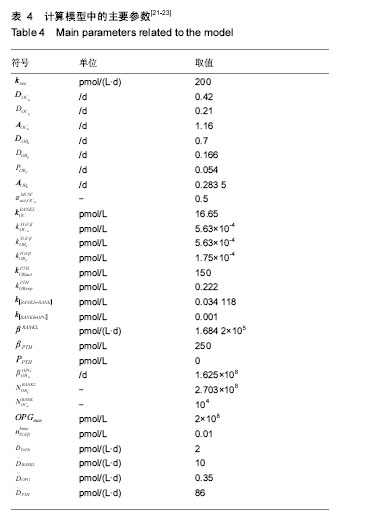| [1] Frost HM.Bone“mass”and the“mechanostat”: a proposal.Anat Rec 1987;219:1-9.[2] Frost HM.Skeletal structural adaptations to mechanical usage (SATMU): 2.Redefining Wolff’s law: the remodelling problem. Anat Rec.1990;226:414-422.[3] Frost HM.Bone’s mechanostat: a 2003 update. Anat Rec.2003; 275A:1081-1101.[4] Tyrovola JB. The “mechanostat theory” of frost and the OPG/Rankl/RANK system. J Cell Biochem. 2015;116(12): 2724-2729.[5] Burger EH, Klein-Nulen J. Responses of bone cells to biomechanical forces in vitro. Adv Dent Res.1999;13:93-98.[6] 吴佳敏.宋关斌力生长因子对骨髓间充质干细胞迁移行为及相关生物力学特性的影响[J].重庆大学,2013.[7] Graham D M, Burridge K. Mechanotransduction and nuclear function. Curr Opin Cell Biol. 2016;40:98-105. [8] Chatterjee S, Fisher A B. Mechanotransduction: forces, sensors, and redox signaling. Antioxid Redox Signal. 2014;20(6): 868-871.[9] LaCroix A S, Rothenberg K E, Hoffman BD. Molecular-scale tools for studying mechanotransduction. Annu Rev Biomed Eng. 2015;17:287-316.[10] Spyropoulou A, Karamesinis K, Basdra EK. Mechanotransduction pathways in bone pathobiology. Biochim Biophys Acta. 2015;1852(9):1700-1708.[11] 林福春.力生长因子E肽(MGF-Ct24E)与应力作用对成骨细胞基因表达影响的基因芯片分析[D]. 重庆大学, 2011.[12] 佟雁翔, 冯卫, 贾燕飞,等. 力生长因子促进骨髓间充质干细胞向成骨细胞的分化[J]. 中国组织工程研究, 2016, 20(32):4717-4724.[13] Cui H, Yi Q, Feng J, et al. Mechano growth factor E peptide regulates migration and differentiation of bone marrow mesenchymal stem cells. J Mol Endocrinol. 2014;52(2):111-120.[14] Xin J, Wang Y, Wang Z, et al. Functional and transcriptomic analysis of the regulation of osteoblasts by mechano‐growth factor E peptide. Biotechnol Appl Biochem. 2014;61(2):193-201.[15] Li H, Lei M, Luo Z, et al. Mechano-growth factor enhances differentiation of bone marrow-derived mesenchymal stem cells. Biotechnology letters. 2015; 37(11): 2341.[16] Schlegel W, Raimann A, Halbauer D, et al. Insulin-like growth factor I (IGF-1) Ec/Mechano growth factor–a splice variant of IGF-1 within the growth plate. PloS one. 2013; 8(10): e76133.[17] Sheng MH, Lau KH, Baylink DJ. Role of osteocyte-derived insulin-like growth factor I in developmental growth, modeling, remodeling, and regeneration of the bone. J Bone Metab. 2014; 21(1):41-54. [18] Bakker A D, Jaspers RT. IL-6 and IGF-1 signaling within and between muscle and bone: how important is the mTOR pathway for bone metabolism?. Curr Osteoporos Rep. 2015;13(3): 131-139.[19] Juffer P, Bakker A D, Klein-Nulend J, et al. Mechanical loading by fluid shear stress of myotube glycocalyx stimulates growth factor expression and nitric oxide production. Cell Biochem Biophys. 2014;69(3):411-419.[20] Yanan Wang, Qing-Hua Qin. Parametric study of control mechanism of cortical bone remodeling under mechanical stimulus.Acta Mechanica Sinica.2010; 26(1):37-44.[21] Buenzli PR, Pivonka P,Gardiner BS,et al.Modelling the anabolic response of bone using a cell population model. J Theor Biol. 2012 ;307:42-52.[22] Scheiner S, Pivonka P, Hellmich C.Coupling systems biology with multiscale mechanics, for computer simulations of bone remodeling。Comput Methods Appl Mech Engrg.2013;254: 181-196.[23] Pivonka P, Buenzli PR, Scheiner S,et al. Dunstan。The influence of bone surface availability in bone remodeling-A mathematical model including coupled geometrical and biomechanical regulations of bone cells.Engineering Structures. 2013;47: 134-147.[24] Garijo N, Fernández J R, Pérez M A, et al. Numerical stability and convergence analysis of bone remodeling model. Computer Methods in Applied Mechanics and Engineering, 2014, 271: 253-268.[25] Graham J M, Ayati B P, Holstein S A, et al. The role of osteocytes in targeted bone remodeling: a mathematical model. PloS one. 2013; 8(5): e63884.[26] Liu Y Q, Han X F, Liu T, et al. A cell-based model of bone remodeling for identifying activity of icarrin in the treatment of osteoporosis. Biotechnology letters. 2015; 37(1): 219.[27] Emil N, Miron GH. Simulation of Bone Mechanical Adaptation using Different Mathematical Models: a Comparative Numerical Study. Key Engineering Materials. 2014; 638.[28] Pennline JA, Werner CR, Lewandowski B, et al. Development of Bone Remodeling Model for Spaceflight Bone Physiology Analysis. 2015.[29] Peng Q,Wang Y,Qiu J,et al.A novel mechanical loading model for studying the distributions of strain and mechano-growth factor expression. Arch Biochem Biophys. 2011;511(1-2):8-13.[30] 鲜成玉.机械拉伸对大鼠成骨细胞生理活性及IGF-1、力生长因子表达的影响[D].重庆大学,2005.[31] 张兵兵,鲜成玉,罗彦凤,等.拉伸刺激下MGF在成骨细胞中的表达及亚细胞定位分析[J].中国科学(C辑:生命科学),2009,39(5): 518-524.[32] Song Y, Yu C, Wang C, et al. Mechano growth factor-C24E, a potential promoting biochemical factor for ligament tissue engineering. Biochemical Engineering Journal. 2016;105: 249-263.[33] Song Y, Xu K, Yu C, et al. The use of mechano growth factor to prevent cartilage degeneration in knee osteoarthritis. J Tissue Eng Regen Med. 2017 Jun 9.[34] Luo Z, Jiang L, Xu Y, et al. Mechano growth factor (MGF) and transforming growth factor (TGF)-β3 functionalized silk scaffolds enhance articular hyaline cartilage regeneration in rabbit model. Biomaterials. 2015; 52: 463-475.[35] Mavrommatis E, Shioura K M, Los T, et al. The E-domain region of mechano-growth factor inhibits cellular apoptosis and preserves cardiac function during myocardial infarction. Mol Cell Biochem. 2013 ;381(1-2):69-83.[36] 辛娟.力生长因子E肽对体外骨形成与骨吸收的调控机制研究[D].重庆大学,2014.[37] Kobayashi Y, Hashimoto F, Miyamoto H, et al. Force-Induced Osteoclast Apoptosis In Vivo Is Accompanied by Elevation in Transforming Growth Factor β and Osteoprotegerin Expression. J Bone Miner Res. 2000;15(10):1924-1934.[38] Tang L, Lin Z, Li Y.Effects of different magnitudes of mechanical strain on osteobalsts in vitro. Biochem Biophys Res Commun. 2006;344(1):122-128.[39] Alon U.An Introduction to Systems Biology: Design Principles of Biological Circuits. CRC Press.2006.[40] Duchemin L, Bousson V, Raossanaly C, et al. Prediction of mechanical properties of cortical bone by quantitative computed tomography. Med Eng Phys. 2008 Apr;30(3):321-328.[41] 宋文静,戴钟铨,吴峰,等. 力生长因子与成骨细胞[J]. 首都师范大学学报:自然科学版,2013,34(1):41-46.[42] Dai Z,Wu F,Yeung EW,et al.IGF-IEc expression, regulation and biological function in different tissues. Growth Horm IGF Res. 2010;20(4):275-281.[43] Matheny RW Jr, Nindl BC, Adamo ML. Minireview: Mechano-growth factor: a putative product of IGF-I gene expression involved in tissue repair and regeneration. Endocrinology. 2010;151(3):865-875.[44] Yang S, Alnaqeeb M, Simpson H, et al. Cloning and characterization of an IGF-1 isoform expressed in skeletal muscle subjected to stretch. J Muscle Res Cell Motil. 1996; 17(4):487-495.[45] Neidlinger-Wilke C, Galbusera F, Pratsinis H, et al. Mechanical loading of the intervertebral disc: from the macroscopic to the cellular level. Eur Spine J. 2014 Jun;23 Suppl 3:S333-343.[46] Chen J C, Castillo A B, Jacobs C R. Cellular and Molecular Mechanotransduction in Bone//Osteoporosis: Fourth Edition. Elsevier Inc., 2013.[47] Lerebours C, Buenzli PR. Towards a cell-based mechanostat theory of bone: the need to account for osteocyte desensitisation and osteocyte replacement. Journal of biomechanics, 2016, 49(13): 2600-2606.[48] Buo AM, Stains JP. Gap junctional regulation of signal transduction in bone cells. FEBS letters. 2014;588(8): 1315-1321.[49] Zhou H. The essential role of Stat3 in bone homeostasis and mechanotransduction[M]. Purdue University, 2014.[50] Berkovich Y, Shapira J, Rosenberg N. Mechanotransduction in Osteoblats. Mesenchymal Cell Activation by Biomechanical Stimulation and its Clinical Prospects, 2016: 49.[51] Zhang Y, Chen S, Pei M. Biomechanical signals guiding stem cell cartilage engineering: from molecular adaption to tissue functionality. Eur Cell Mater. 2016, 31: 59-78. |
.jpg)

.jpg)
.jpg)
.jpg)
.jpg)
.jpg)
.jpg)
.jpg)
.jpg)
.jpg)

.jpg)